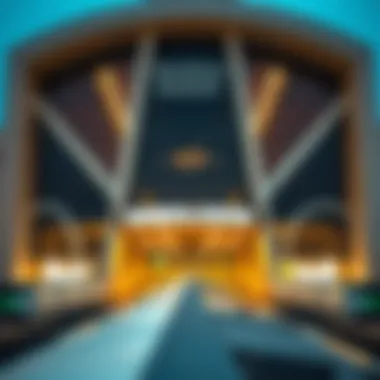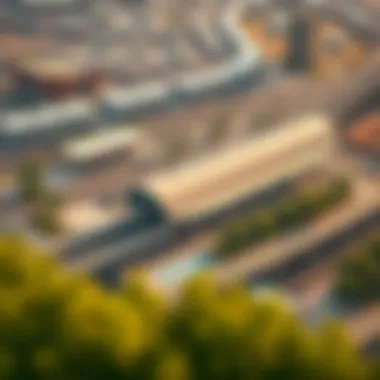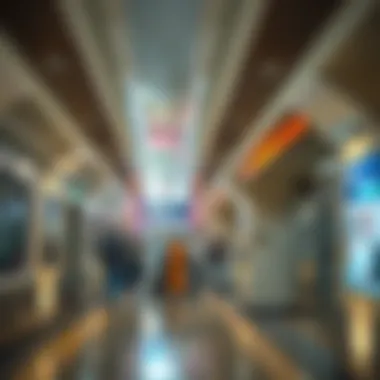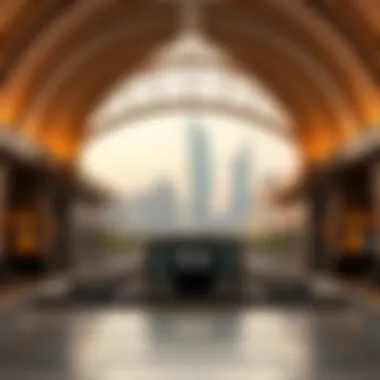Exploring Rashidiya Metro Station's Impact on Dubai


Intro
Dubai's skyline is a testament to its rapid growth and visionary architecture. Amidst the tall towers and sprawling developments, the Rashidiya Metro Station stands out as a keystone in the heart of the city’s public transport framework. This article digs deep into the Rashidiya Metro Station, illuminating its multifaceted significance not just as a transit point but also as a catalyst for urban mobility and real estate dynamics.
The Rashidiya Metro Station is more than just a stop along the Red Line; it embodies the convergence of architectural innovation and urban planning. With its unique design and strategic location, it serves not only the locals but also the expat community. This station connects various neighborhoods, making commuting for work or leisure more convenient.
In the forthcoming sections, we will dissect several relevant dimensions—from the latest market trends in the vicinity to the investment opportunities opening up as the area continues to evolve. By examining both current property prices and anticipated future projections, potential buyers and investors can make informed decisions that align with Dubai's rapid urban development.
Moreover, the connection between efficient transportation and socio-economic growth cannot be overlooked. The Rashidiya Metro Station stands as a vital link in this chain, influencing lifestyle choices and real estate demands. Thus, a closer look at the socio-economic implications will paint a clear picture of the broader context within which this station operates.
Join us as we navigate through each aspect, offering valuable insights and analysis that will prove indispensable for everyone—whether you’re an investor, an agent, or simply a resident passionate about urban dynamics.
Overview of Rashidiya Metro Station
The Rashidiya Metro Station is more than just a stop on Dubai's extensive transit network; it’s a crucial hub that reflects the city's ambition and growth in urban transportation. This station marks the beginning of the Red Line and serves as a critical link for residents and visitors alike. Understanding the essential features and layout of Rashidiya offers valuable insights into how it supports the daily life and commuting patterns in a bustling metropolis.
Location and Accessibility
Positioned strategically in the Al Rashidiya area, the Rashidiya Metro Station is easily accessible via major roads like the Sheikh Mohammed Bin Zayed Road and Al Reba’a Street. This prime location facilitates a smooth commute for a diverse demographic—be it the bustling families, hardworking professionals, or intrigued tourists.
Moreover, the station isn’t just a transportation point; it encompasses multi-modal integration, providing service links to other public transport options. By being adjacent to various bus routes and taxi services, it acts as a one-stop-shop for individuals aiming to navigate the city effectively.
Historical Context
The inception of Rashidiya Metro Station dates back to the early 2000s when Dubai was undergoing rapid transformation. Conceived as part of a grand vision for urban planning and sustainability, the station opened its doors in 2010. At that time, Dubai was actively seeking to ease traffic congestion and bolster public transport as a viable alternative.
The developments around Rashidiya reflect Dubai's forward-thinking attitude in adapting to population growth and increasing urban demands. It was important not just for connectivity, but also as a statement of Dubai’s modernity—highlighting the shift from personal vehicles to effective public transport solutions.
Understanding the historical context of the Rashidiya Metro Station provides a lens through which we can view Dubai's rapid evolution and its efforts to embrace innovative infrastructure. Not only does it serve practical transportation needs, but it also stands as a testament to the city’s commitment towards a sustainable urban environment.
Architectural Design and Features
The Rashidiya Metro Station serves as a remarkable example of modern architectural design, merging functionality with striking aesthetics. This design is not merely about appearances; it plays a crucial role in enhancing the station's operational efficiency and user experience. A well-thought-out architectural layout can ease passenger flow, improve security measures, and contribute significantly to the sustainability efforts of Dubai's urban landscape. In this context, the various architectural elements and features specifically employed at Rashidiya deliver benefits that extend beyond mere transit; they signify a vision for future urban mobility.
Innovative Design Elements
The innovative design elements of the Rashidiya Metro Station are both cutting-edge and practical. The station's exterior boasts a sleek façade, constructed using materials that reflect both sunlight and heat, thereby minimizing energy consumption. Noteworthy is the incorporation of large glass panels, which allow natural light to flood the interior, creating an inviting atmosphere for commuters.
Moreover, the station's roof features an ergonomic structure that is designed to channel rainwater to drainage systems, emphasizing sustainability through thoughtful engineering. The integration of smart technology is evident as well, from automated ticketing kiosks to digital displays providing real-time information on train schedules. By adopting these innovations, the station enhances passenger convenience while also promoting a forward-thinking image.
Interior Layout and Facilities
When one steps inside the Rashidiya Metro Station, they are greeted with a meticulously planned interior layout. The space is organized in a way that accommodates a vast number of passengers moving seamlessly through ticketing, waiting areas, and boarding platforms. The spacious hallways are lined with clear signage—vital for easy navigation, especially for first-time visitors or those unfamiliar with the system.


Facilities such as spacious waiting lounges and well-placed restrooms contribute to a positive commuting experience. Additionally, food and retail outlets strategically placed offer options for travelers on the go, further enhancing convenience. The combination of aesthetic appeal and practical facilities ensures that the Rashidiya Metro Station not only serves as a transit point but also as a vibrant part of the community.
The design of Rashidiya Metro Station reflects a commitment to creating spaces that are functional, beautiful, and conducive to a high quality of life.
Investors, homebuyers, and urban planners should take note of how the architectural choices in Rashidiya not only optimize travel but also set a benchmark for future projects in Dubai and beyond. The careful balance of innovation and utility serves as a guiding principle for upcoming developments, ultimately shaping a more efficient urban environment.
Operational Significance
The Rashidiya Metro Station is no mere stop along Dubai's Metro line; it represents a mechanism of urban efficiency that interweaves with the fabric of the city. Understanding the operational significance of this station unveils layers of connectivity and bolstered mobility that extend beyond just a transit hub. In a metropolis renowned for its rapid urbanization, Rashidiya effectively bridges gaps—between people, neighborhoods, and economic opportunities.
Public Transport Integration
Rashidiya Metro Station serves as a vital artery in Dubai’s public transport network. It’s not isolated; it works in unison with buses and taxis to create a seamless travel experience. Passengers can easily transition from the metro to an extensive bus service, ensuring that no commuter is left stranded. This integration introduces convenience, empowering citizens and visitors alike.
The volume of interconnectivity can be observed through several tangible avenues:
- Multi-Modal Transport Links: The station provides direct access to bus services, allowing seamless transfers and route options for commuters.
- Accessibility for All: Rashidiya's design accommodates everyone, including the elderly or those with disabilities, paving the way for an inclusive public transport system.
- Strategic Location: Positioned strategically, it offers pivotal access to key destinations in the city, from work hubs to leisure areas, optimizing the daily commutes for numerous users.
This level of integration is no accident. By embedding Rashidiya into a network of public transportation options, the city fosters an environment where reliance on personal vehicles decreases, subsequently easing congestion and removing some of the burdens from the road.
Impact on Commute Times
Time efficiency is a fundamental metric when evaluating the efficacy of any transport system. Rashidiya Metro Station contributes significantly to reduced commute times, which is essential for anyone living or working in the bustling city. By providing rapid transit options, the station considerably shortens travel durations, enabling individuals to maximize their day.
- Fast Trains: The frequency of the train services allows passengers to minimize waiting times, which effectively compresses overall travel times.
- Reduced Traffic Congestion: With more people opting for the metro, the vehicular traffic in surrounding areas diminishes, enhancing flow and speed for those who do drive.
- Predictable Schedules: The timetables are predictable, offering commuters reliability that fosters better planning of their daily schedules.
"The time saved through the use of Rashidiya Metro Station is not merely an abstract figure; it translates into enhanced productivity for local businesses and a better quality of life for residents."
Socio-Economic Implications
The Rashidiya Metro Station serves as a vital cog in the machine of Dubai's economic landscape, interlinking urban mobility with broader economic trends. This section unpacks how the station has become intertwined with real estate and employment opportunities, shaping the socio-economic fabric of the region. Those looking to invest, reside, or develop in this area will find valuable insights in this examination of its implications.
Real Estate Dynamics
Influence on Property Values
The presence of Rashidiya Metro Station has notably influenced property values in its vicinity. Properties located within easy reach of the station often see an uptick in demand, translating to higher market prices. It's simple: people prefer the convenience that comes with proximity to public transport. This has essentially made areas close to the station a hotbed for real estate investment.
Interestingly, more than just convenience, the station adds an aura of prestige. When buyers hear about a property being situated near a metro station, their perception changes—what was once just a neighborhood suddenly becomes an attractive prospect. This influence on property values helps shape the broader market dynamics in Dubai, making it evident that location matters a great deal.
However, there are some strings attached. Prices can become inflated rapidly, making it hard for average residents to enter the market. This can lead to social stratification, where only those with higher income can afford housing, pushing lower-income families further away from essential amenities.
Emerging Neighborhood Trends


Emerging trends in neighborhood dynamics indicate a shift towards areas surrounding Rashidiya Metro Station. As the station facilitates better connectivity, it attracts businesses, restaurants, and retail outlets, creating vibrant living spots. New developments are popping up, not only enhancing urban living conditions but also driving up competition among local businesses.
The unique aspect here is the evolution of community spaces. Neighborhoods that once had sparse amenities are now bustling with life—a direct result of increased foot traffic from commuters. Green spaces, cafes, and co-working spaces are springing up, and they serve as major selling points for prospective homebuyers.
Still, while these trends bode well for some, they can also result in challenges like gentrification, which displaces long-term residents who can’t afford rising rents. The push towards modern living often causes the loss of traditional cultural elements, which can be troubling.
Employment Opportunities
Rashidiya Metro Station has indirect yet substantial implications for employment in Dubai. As the metro expands its reach, businesses flourish, increased connectivity leads to more job opportunities that attract a diverse workforce. In effect, the station acts as a gateway for people from various backgrounds and skillsets, creating a melting pot of talent.
With this influx of people working near the station, commuting times decrease, and employees spend less time navigating the urban sprawl. More people can access employment opportunities they might not have considered before, changing the landscape of job accessibility in the city.
In summary, as Rashidiya Metro Station plays its role in this fabric of socio-economic implications, it becomes clear that its influence extends beyond just transit. Property values, neighborhood dynamics, and employment opportunities intersect in a complex dance, creating a rich narrative tailored for potential investors, residents, and developers alike.
The Rashidiya Metro Station exemplifies how infrastructure can direct the flow of economic and social patterns in a rapidly developing city.
By focusing on these socio-economic implications, stakeholders can better understand how trends around the station could shape their own experiences and investments in Dubai's ever-evolving landscape.
For further insights, check out Dubai's Economic Overview and Transportation in Dubai.
Keywords
- Rashidiya Metro Station
- Property Values
- Real Estate Dynamics
- Neighborhood Trends
- Employment Opportunities
Find further details regarding community engagement and future prospects at Wikipedia to keep an eye on development directions.
Future Developments and Prospects
The Rashidiya Metro Station holds significant importance not just as a transit point, but also as a catalyst for future urban growth in Dubai. As the city continues to evolve, the station stands at the crossroads of development and opportunity, impacting a variety of stakeholders including investors, developers, and local residents. Understanding the developments associated with Rashidiya is vital for those looking to capitalize on its strategic advantages.
Planned Infrastructure Enhancements
Recent announcements indicate a wave of planned infrastructure enhancements that aim to elevate Rashidiya Metro Station as a key player in Dubai's broader transportation strategy.
Some of the notable projects include:
- Extended Rail Lines: There are discussions about expanding the rail lines to connect with nearby areas, improving access for commuters and tourists alike. Such extensions aim to alleviate congestion and provide seamless travel experiences throughout the emirate.
- Integrated Transport Hubs: The design plans for integrating other transport modes, such as buses and taxis, are already in motion. This will facilitate smoother transitions for travelers and enhance the overall efficiency of public transport in the vicinity.
- Smart Facilities: With technology paving the way for modern travel, enhancements like smart ticketing systems and real-time information displays will significantly improve passenger experience.
These enhancements not only promise to streamline travel but also bolster property attractiveness in the surrounding areas, making them a magnet for future investments.
Vision for Urban Expansion
The vision behind Rashidiya Metro Station extends far beyond its current operational capabilities. Considering the growth of Dubai's urban landscape, there is a clear trajectory toward expansion. This vision encompasses:
- Mixed-Use Developments: There are plans to encourage mixed-use developments around the station, blending commercial, residential, and recreational spaces that can cater to an increasingly diverse population.
- Green Spaces: The integration of parks and green areas is also a part of this vision, promoting sustainability and improving the overall quality of life for residents.
- Cultural Hubs: Future developments may incorporate cultural institutions or community centers, contributing to the social fabric of the neighborhood and making it attractive to expats and locals alike.
The synergy between Rashidiya Metro Station and urban expansion illustrates a forward-thinking approach that, if executed well, could redefine the living dynamics in this part of Dubai.


Investors and homebuyers should closely monitor these developments, as they will undoubtedly influence property values and the living experience in the surrounding neighborhoods. While the investments are indeed substantial, the potential returns seem equally promising.
Rashidiya Metro and Sustainability
The Rashidiya Metro Station symbolizes more than just a point on a transport map; it embodies a central theme of sustainability in urban development. As cities grapple with the double-edged sword of growth and environmental stewardship, Rashidiya serves as a case in point of how integrating sustainable practices in public transport can yield tangible benefits for both the environment and the community.
Public transportation systems like the Rashidiya Metro play a crucial role in reducing the carbon footprint of a metropolis. With the staggering pace of urbanization — Dubai's population swells rapidly — effective public transport is essential. By providing an accessible alternative to private vehicles, Rashidiya Metro helps to alleviate road congestion, lowering harmful emissions from idle cars.
Environmental Considerations
When discussing environmental considerations, several aspects come into play. The design and construction of Rashidiya Metro Station were executed with a keen eye on minimizing environmental impact. Various materials used were chosen for their sustainability attributes, promoting energy efficiency and longevity. This foresight ensures that the station operates not just as a means of transport, but as an environmentally-conscious structure.
Moreover, energy efficiency was a top priority. The station utilizes solar panels to supplement its energy needs. This renewable energy source reduces dependence on traditional power methods, aligning with Dubai's vision of becoming a green economy. Changes like these create a ripple effect in the community’s attitude towards energy consumption, fostering a culture where sustainability becomes second nature.
Another critical element is water conservation. Technologies integrated into water management systems help in recycling and reducing water wastage.
- Rainwater harvesting techniques
- Greywater recycling systems
These strategies not only conserve precious water resources but also bolster local ecosystems by maintaining groundwater levels.
"Sustainable practices in urban transit are not just a trend; they redefine the connection between community growth and ecological responsibility."
Community Engagement Initiatives
Beyond its structural features, community engagement initiatives surrounding the Rashidiya Metro Station signal a thoughtful approach to urban living. Engaging with local residents and stakeholders, the initiative seeks to educate and involve the community in sustainability efforts related to the station.
Workshops and programs organized around environmental stewardship foster a sense of ownership among residents. Residents are encouraged to take part in clean-up drives, tree planting events, and sustainability awareness campaigns. This participatory angle serves to unify diverse groups within the community while promoting environmental education and responsible practices.
Additionally, meaningful partnerships with local schools and community organizations amplify outreach efforts. Exposing young minds to the importance of sustainability through projects and educational activities can cultivate a future generation dedicated to ecological preservation.
Epilogue
In considering the Rashidiya Metro Station, one is led to a broader understanding of the intersection between transportation and urban life. This station is not just a point of transit but a reflection of Dubai's ambition, going hand-in-hand with its dynamic growth. The need for efficient mobility solutions in an ever-expanding city has made Rashidiya a key player in reshaping how people navigate their daily lives.
Summarizing Key Insights
Several pivotal points emerge from our exploration of Rashidiya Metro Station:
- Accessibility: Located strategically, it offers easy connectivity to both local and regional destinations, making it a linchpin for daily commuters.
- Socio-Economic Impact: The station significantly affects nearby real estate, driving demand and influencing property values. New neighborhoods are springing up, encouraging a vibrant local community.
- Sustainability Initiatives: Efforts to engage the community and incorporate environmental practices are in sync with global trends toward sustainable urban living.
- Future Development: The ongoing plans for infrastructure enhancement promise to further improve urban connectivity and cater to Dubai’s ever-increasing population.
Final Thoughts on Rashidiya Metro Station
The Rashidiya Metro Station stands as a testament to modern urban planning in a city known for its rapid development and innovative spirit. As Dubai continues to evolve, this station embodies a shift towards a more connected and accessible city. Investors, developers, and residents alike can see the potential it presents, not just as a transport hub, but also as a catalyst for economic growth and community development.
This examination of Rashidiya Metro highlights its crucial role in supporting the wider structural framework of Dubai’s public transport ecosystem. As the city prepares for further urban expansion, the Rashidiya Metro Station will likely remain at the forefront, demonstrating how thoughtful infrastructure can lead to sustainable living environments moving forward.
"Rashidiya is not just about moving from point A to point B; it’s about creating connections that drive the future of urban life."
To explore more about transportation advancements in Dubai, check out additional resources on Wikipedia or visit Dubai's official government site.















